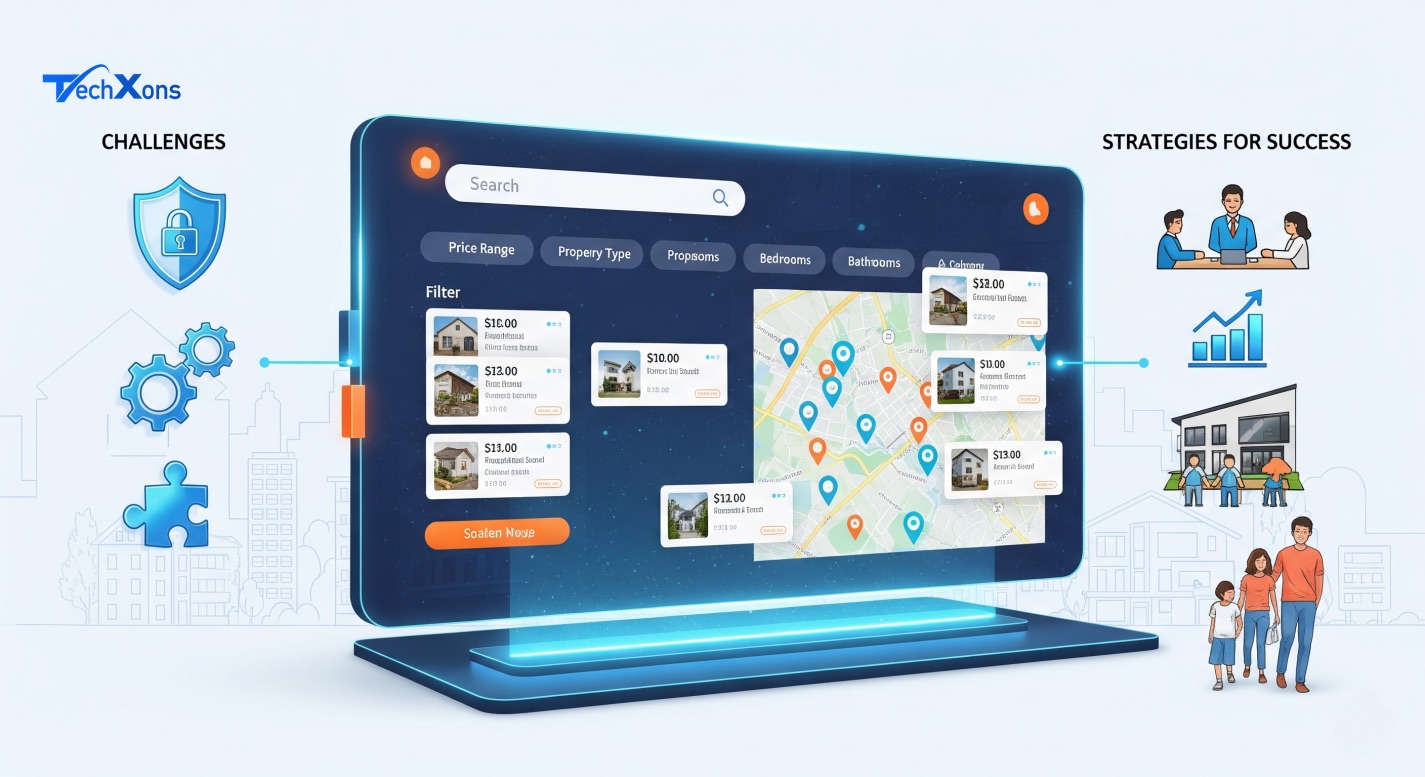
- By TechXons
- 09 Sep, 2025
- IT Consultancy
Launching a Zillow-Like Platform: Key Challenges and Strategies for Success
This article examines the challenges of launching a real estate platform like Zillow, a leader in proptech known for its Zestimate and user-friendly marketplace. Key hurdles include real-time data synchronization, catering to diverse user needs, complex design, interactive features, scalability, legal compliance, monetization, and customer support. Solutions involve leveraging Techxons’ Zillow clone scripts, which offer MLS/IDX integrations, AI-driven features, and scalable architecture. The article provides SEO strategies for “Zillow clone” visibility, future predictions like AI analytics and blockchain, and a step-by-step launch guide. Case studies and Techxons’ solutions highlight how startups can overcome obstacles and thrive in the competitive real estate market.
The real estate world has really embraced the digital age, with platforms like Zillow leading the way. Zillow, a giant in the proptech arena, has completely changed how we buy, sell, and rent properties by providing a smooth, data-driven experience. For entrepreneurs and startups, creating a platform similar to Zillow presents a huge opportunity, especially since more than 90% of property searches kick off online. But let’s be real—duplicating Zillow’s success isn’t easy. There are plenty of technical challenges and regulatory obstacles to navigate. For companies like Techxons, which focus on offering solution clones, building a Zillow clone can be a shortcut, but it still requires careful planning.
This article dives into the key challenges of launching a real estate platform like Zillow, shares practical solutions, and showcases how Techxons’ Zillow clone solutions can help startups thrive. By honing in on the keyword “Zillow clone,” we’re aiming to create an SEO-friendly guide that attracts organic traffic while providing valuable insights for aspiring proptech entrepreneurs. Whether you’re looking to reach buyers, sellers, renters, or agents, grasping these challenges is the first step toward building a successful real estate marketplace.
The Zillow Phenomenon: A Blueprint for Success
Founded in 2004 by Rich Barton and Lloyd Frink, Zillow shook up the real estate industry by making property data available to everyone. Its standout feature, the Zestimate, gives home value estimates, while its marketplace links buyers, sellers, renters, and agents. With over 231 million unique users in Q2 2024 and a solid array of tools like 3D tours, mortgage calculators, and real-time listings, Zillow really sets the standard high.
A Zillow clone is designed to mimic this model: a user-friendly platform that combines property listings, advanced search capabilities, and additional services like financing or analytics. Techxons provides customizable Zillow clone scripts that come packed with these features, allowing startups to hit the ground running without the hassle of building everything from scratch. However, achieving success depends on tackling the following hurdles.
Key Challenges in Launching a Zillow Clone Platform
1. Real-Time Property Data Synchronization
Outdated listings can really kill the vibe in real estate. Picture a user spotting their dream home on your Zillow clone, only to find out it was sold weeks ago. Having real-time data is essential, but getting there is no walk in the park.
Why It’s a Challenge:
The Multiple Listing Service (MLS) databases, which gather property information, are all over the place. Each MLS operates on its own schedule, with some updating every 15 minutes while others do it daily. Without proper synchronization, your platform risks displaying stale or duplicate listings, which can really hurt user trust. Competitors like Trulia and Redfin have nailed real-time updates, raising the bar for user expectations.
Solutions:
- Integrate MLS/IDX APIs: Team up with trusted data providers like Realtor.com or CoreLogic for real-time feeds. Techxons’ Zillow clone comes with pre-built integrations for MLS/IDX, making this process smoother.
- Automated Pipelines: Leverage scalable backend tools like Apache Kafka or AWS Lambda to process updates on the fly. This way, price changes, new listings, or removals are reflected in real time.
- Data Verification: Use AI-driven checks to catch inconsistencies, like mismatched addresses or outdated statuses.
By focusing on real-time synchronization, your Zillow clone can meet industry standards and keep users engaged in their search for accurate listings.
2. Understanding Diverse User Needs
A real estate platform caters to a variety of users: buyers, sellers, renters, agents, and investors. Each group has its own set of expectations, making it tough to create a one-size-fits-all experience.
Why It’s a Challenge:
When it comes to real estate, buyers are on the lookout for in-depth insights—think school ratings, crime stats, and commute times. Renters, on the other hand, value flexibility, like pet policies or short-term leases. Agents are in need of effective lead generation tools, while investors are after solid market analytics. Creating a Zillow-like platform means finding a way to meet all these diverse needs without overwhelming users. If you miss the mark, you risk low engagement or high churn rates.
Solutions:
User Segmentation: Harness the power of AI to customize interfaces based on user type. For instance, Techxons’ Zillow clone provides personalized dashboards tailored for buyers, renters, and agents.
Advanced Filters: Implement comprehensive search filters for things like bedrooms, price ranges, or amenities such as “pet-friendly.” Don’t forget to add niche filters, like “walkable neighborhoods” or “investment potential.”
Personalized Recommendations: Utilize machine learning to recommend listings or services based on user behavior. For example, renters searching for “apartments near me” could be shown listings that include virtual tours.
By catering to these varied needs, your platform can foster loyalty among different user groups, which is a key factor in Zillow’s success.
3. Complex Design and Development
Creating a platform similar to Zillow demands a perfect mix of user-friendly front-end design and a robust back-end system. This isn’t an easy feat, as the platform needs to manage millions of listings while still being intuitive.
Why It’s a Challenge:
Zillow’s interface strikes a balance between being clean and feature-rich, complete with interactive maps, high-quality images, and handy tools like mortgage calculators. Developing something like this requires a deep understanding of UI/UX design, database management, and cloud infrastructure. Startups often underestimate the resources required, which can lead to delays or less-than-stellar products.
Solutions:
Choose the Right Tech Stack: Go for scalable frameworks like React for the front end, Node.js for the back end, and MongoDB for managing large datasets. Techxons’ Zillow clone is built on these kinds of stacks, ensuring top-notch performance.
Make Mobile Optimization a Priority: Did you know that over 70% of real estate searches happen on mobile devices? It's crucial to ensure your Zillow clone is responsive and offers a smooth, app-like experience.
Utilize Pre-Built Solutions: Techxons has ready-to-use Zillow clone scripts that come packed with features like interactive maps and 3D tour integrations, which can really cut down on development time.
A well-crafted platform reduces user friction, leading to better retention rates and improved rankings for searches related to “Zillow clone.”
4. Interactive Features Users Crave
Today’s users expect more than just basic listings. They want features like virtual tours, AI-driven recommendations, and in-app messaging as standard offerings.
What Makes It Challenging:
Adding interactive features means you need advanced technologies like augmented reality (AR) for 3D tours or natural language processing (NLP) for chatbots. These can be resource-heavy, and if not done right, they can frustrate users. For instance, a slow virtual tour could turn potential buyers away.
Solutions:
- Embrace AR/VR: Leverage tools like Matterport for 3D tours, seamlessly integrated into Techxons’ Zillow clone for a smooth user experience.
- AI Chatbots: Implement NLP-powered chatbots to quickly respond to inquiries about listings or financing, enhancing response times.
- Real-Time Notifications: Send push alerts for new listings or price drops to keep users engaged.
Interactive features set your Zillow clone apart, making it the go-to choice for tech-savvy users.
5. Scalability and Performance
As your platform expands, it needs to manage increasing traffic and data without crashing. Zillow handles millions of users and listings every day, setting the standard for any clone.
What Makes It Challenging:
High traffic during peak times (like the spring homebuying season) can put a strain on servers. Slow load times or outages can push users toward competitors. Plus, managing large datasets—like property images, videos, and analytics—requires a strong infrastructure.
Solutions:
- Cloud Hosting: Opt for AWS or Google Cloud for scalable, dependable hosting. Techxons’ clones are designed to thrive in cloud environments.
Load Balancing: Spread out the traffic across your servers to avoid any bottlenecks.
Caching Mechanisms: Use Redis or Memcached to make data retrieval faster.
Scalability is key to keeping your Zillow clone responsive, which in turn boosts user trust and improves SEO performance.
6. Legal Compliance and Data Privacy
Real estate platforms deal with sensitive information—like personal details, financial data, and property records—so compliance is absolutely essential.
Why It’s a Challenge:
Laws such as GDPR, CCPA, and various local real estate regulations differ from one region to another. Not following these rules can lead to hefty fines or even bans. Plus, MLS agreements often limit how data can be used, making integrations trickier.
Solutions:
Compliance Frameworks: Make sure your Zillow clone meets data protection laws. Techxons comes with built-in compliance tools for GDPR and CCPA.
Secure Data Handling: Implement encryption and secure APIs for accessing MLS data.
Transparent Policies: Clearly outline your privacy policies to users, which helps build trust.
Compliance is crucial for maintaining your platform’s reputation and ensuring its longevity.
7. Monetization Strategy
To turn your Zillow clone into a money-making venture, you need a solid revenue model.
Why It’s a Challenge:
Zillow makes money through advertising (like their Premier Agent program), lead generation, and transaction fees. Startups need to find a balance between monetization and affordability to keep users interested. If you charge too much, sellers or agents might just go to the competition.
Solutions:
Freemium Model: Provide free basic listings, while offering premium features like promoted listings or analytics for a fee.
Agent Subscriptions: Charge agents for lead generation tools, similar to Zillow’s Premier Agent model.
Partnerships: Team up with mortgage lenders or insurers to earn referral fees.
Techxons’ Zillow clone comes with monetization modules that make setting up revenue streams a breeze.
8. Customer Support as a Differentiator
Outstanding customer support is what sets Zillow apart. Users expect quick solutions for issues like booking disputes or technical hiccups.
Why It’s a Challenge:
Scaling support for a growing user base can get pretty expensive. When support falls short, it can lead to negative reviews, which can really hurt your platform’s reputation and SEO rankings.
Solutions:
AI Chatbots: Implement AI to tackle common questions, leaving the more complex issues for your human agents.
24/7 Support: Provide multi-channel support (email, chat, phone) to meet the needs of users around the globe.
Feedback Loops: Gather user feedback to enhance features, as Techxons’ clones do with their built-in analytics.
Great support boosts user retention, which is crucial for organic growth.
Leveraging Techxons’ Zillow Clone for Success
For startups, creating a Zillow-like platform from scratch can set you back anywhere from $50,000 to $200,000 and take months to complete. Techxons’ Zillow clone solutions significantly reduce this time and cost, offering pre-built scripts that include:
MLS/IDX Integration: Get real-time data feeds for accurate listings.
AI Features: Incorporate recommendations, pricing tools, and chatbots.
SEO Tools: Built-in optimization for keywords like “Zillow clone.”
Scalable Architecture: Ready for the cloud to handle high traffic.
Customizability: Adaptable for specific niches like luxury homes or rentals.
By choosing Techxons, startups can launch in just weeks, allowing them to focus on branding and marketing instead of getting bogged down in coding.
SEO Strategies for Organic Reach
To rank for “Zillow clone,” make sure to optimize your content:
Keyword Integration: Naturally include “Zillow clone” in your titles, headers, and meta descriptions.
Long-Form Content: Aim for articles like this one (around 4,000 words) to establish authority with search engines.
Backlinks: Contribute guest posts to real estate blogs or collaborate with industry websites.
Local SEO: Target keywords like “real estate platform near me” to attract geo-specific traffic.
Social media campaigns and email newsletters can help amplify your reach, driving more traffic to your Zillow clone.
Predictions for Zillow Clones in 2025 and Beyond
The proptech market is expected to grow at a 12.8% CAGR through 2030, fueled by advancements in AI, AR, and blockchain. Future Zillow clones might:
Harness AI for Predictive Analytics: Anticipate market trends or understand buyer behavior.
Incorporate Blockchain: Guarantee clear and transparent property records.
Enhance AR Features: Provide engaging virtual staging experiences.
Techxons’ clones are designed with these trends in mind, ensuring they stand the test of time.
Case Studies: Insights from Real-World Applications
Redfin: Leverages AI for pricing and lead generation, giving Zillow a run for its money. Its emphasis on cost efficiency motivates clones to focus on affordability.
Opendoor: Simplifies the buying and selling process with instant offers. Clones can take a page from their book and implement similar automation.
Techxons Clients: Many have rolled out regional Zillow clones, racking up over 50,000 users in just a year by utilizing pre-built features.
Step-by-Step Guide to Launching Your Zillow Clone
Market Research: Pinpoint underserved niches (like vacation rentals).
Select Techxons’ Clone: Pick a customizable script that includes the features you want.
Integrate Data Sources: Link MLS/IDX for real-time updates.
Customize and Brand: Infuse your unique logos, colors, and features.
Test Thoroughly: Make sure it’s mobile-friendly and performs well.
Launch and Promote: Utilize SEO, social media, and partnerships.
Scale: Analyze user data to broaden your offerings.
Conclusion: Crafting the Next Zillow
Starting a Zillow-like platform is an ambitious move with huge potential. By tackling challenges such as real-time data, user needs, and compliance, startups can carve out a niche in the proptech arena. Techxons’ Zillow clone solutions give you a head start, incorporating AI, scalability, and monetization tools. With smart marketing and a strong focus on user experience, your platform can tap into the rising demand for online real estate solutions.




